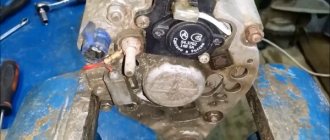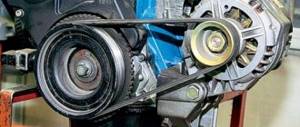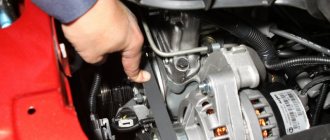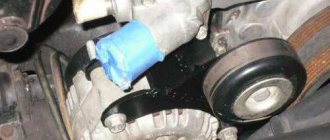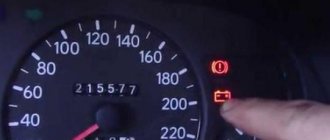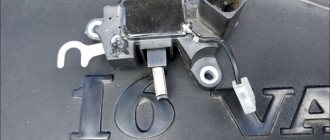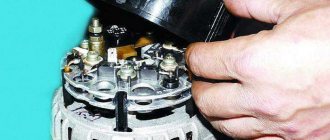How to identify a generator malfunction
What happens if the generator is faulty, what signs indicate this, how to fix it, and why are modern expensive car generators much more reliable than their simpler predecessors?
We will name the main symptoms and typical defects and explain how you can easily check the quality of the generator yourself.
Every car has a generator that produces electricity. A modern alternator supplies the necessary energy to numerous consumers in a vehicle. Although alternators should ideally last as long as the life of the car, defects in them are not uncommon. But the generator itself is not always the cause of the power shortage problem.
Why do you need a generator in a car, and why can’t even a working one always charge the battery?
photo: nairaland.com
Modern cars are usually equipped with a three-phase alternating current electric generator.
While driving, it generates energy for all electricity consumers in the car (the voltage corresponds to plus or minus 14 volts and is maintained by the regulator). The more sophisticated the car, the more consumers it has and the more current it requires. Air conditioning, heated mirrors, rear/front windows, heated seats, cruise control and so on and so forth, from the latest electronic assistants to the fuel pump and engine control unit. see also
The use of a 48-volt on-board electrical network
In addition, as many people know, even those who are not very familiar with the structure of cars, the generator is responsible for charging the battery and ensuring that it always remains fully charged while driving. This is very important, since the battery, in turn, is an energy storage device in the car and, so to speak, a conditional backup generator that supplies current, which is sometimes even required while driving.
IMPORTANT! Do not forget to turn off energy consumers when the engine is off. If you turn off the engine, turn off all energy consumers: headlights, radio (if you use the radio for a long time on an old battery, the car may not start after parking - there is not enough current), even the interior lighting.
Use a fresh battery of normal capacity. Moreover, if the car is used for short trips, especially in winter, when it is necessary to turn on voracious consumers of electricity such as glass/mirror heaters, heated seats, then even a working generator will not have time to saturate the battery with energy, which will ultimately lead not only to the inability to start the car, but also to battery degradation.
Why can't modern generators have enough power?
photo: cardekho.com
As we said above, modern cars have three-phase generators. Gone are the days (around the late 70s - early 80s) when unproductive generators produced little power, depending heavily on engine speed. This could be observed on old motorcycles and scooters: when the engine is idling, the headlights glow dimly. As soon as you turn the throttle, the light will light up brightly.
Now, even at idle (from 650 to 900 crankshaft revolutions per minute), modern generators generate sufficient power and, therefore, produce the required volumes of electricity to supply all consumers in the car.
Could the generator not have enough power to power all consumers in the car?
Why is it important that our cars have three-phase generators? The fact is that, compared to older systems (DC and AC generators), three-phase generators are not only more powerful, but also more reliable, smaller and lighter (about nine kilograms for a passenger car).
If there is not enough current, it means that the problem is hidden in the generator - a breakdown has occurred. Generator power is coordinated with consumers in the car
The maximum power produced by the generator can be ten percent less than the power of all consumers in the car if they are turned on at the same time. In such a situation (which is actually difficult to imagine, at least because you are unlikely to turn on the heating and at the same time the air conditioning at full power), the difference of this ten percent will be compensated by the battery mentioned above as a backup power source.
So, as we wrote above, due to the constant increase in the number of electricity consumers in the car, the charging current of alternating current generators continues to increase. If in the 1980s 50 amperes of current was sufficient for a compact car, today generators produce from 100 to 250 amperes depending on the type, class, configuration of the car, and so on.
By the way, the driver of the new impetus for development was not only the comfort features that appeared in modern cars, but rather the technologies used in engines, such as high-pressure fuel pumps or injector solenoid valves, that is, everything that requires electricity.
Signs of wear on the alternator belt and its replacement
In this article we will tell you about the main signs of wear on the alternator belt. We will also discuss how to replace the belt yourself with just a few tools on hand.
SIGNS OF GENERATOR BELT WEAR AND ITS REPLACEMENT
Good afternoon, we present to your attention an up-to-date article for any car enthusiast on the topic: symptoms and signs of poly V-blade
,
rivulet
belt or, as people call it,
generator belt
. In the article we will also touch on how to independently replace, dismantle and install a new belt with just a few tools on hand.
Almost every car on the planet is equipped with a serpentine belt, which is the most reliable element of transmitting energy from the drive shaft to the driven shaft. The energy transfer itself occurs as a result of the interaction of the working surface of the drive belt with wedge-shaped teeth. Thanks to the alternator belt, not only the start and start of the car is carried out, thanks to the operation of the generator from it, but also, as a rule, the operation of the air conditioner and power steering of the vehicle is ensured. Since in modern cars the functions of the belt on the air conditioner and the generator are often combined.
1. Checking alternator belt wear at home
As a rule, according to the regulations, alternator belts are changed every 60-80 thousand kilometers, it all depends on the operating conditions of the car and its technical characteristics. However, it happens that belts fail completely unplanned, much earlier.
Before replacing the V-ribbed (ribbed) belt, we must make sure that it is unsuitable.
The main symptoms of a belt's unsuitability are its clear whistle, which begins to appear under the maximum load of electrical appliances in the vehicle, usually when the headlights are on low beam. When, when starting the engine and giving a small gas supply, we begin to hear a characteristic whistle under the hood, then this symptom is an unambiguous sign that the alternator belt has been stretched or weakened.
When we start to hear such a whistle, it is not critical and not scary, but of course it is not pleasant. It’s just that such a sound begins to indicate the beginning of problems with the alternator belt and its possible imminent failure. The fact is that when the belt weakens, it becomes more difficult for the generator to work and it is not able to produce the maximum charge. The worst thing can happen is when the constant sound of the generator occurs without load and with load. This already indicates that an urgent replacement of the belt is necessary.
2. Diagnosis of alternator belt damage
and its replacement
Before replacing the poly V-belt, it is necessary to visually inspect it. To do this, we dismantle it and check for signs of mechanical wear, cuts, deep cracks and tears. If we haven’t visually detected everything previously described, then we check the tension. Most likely, the problem lies precisely in the tension of the belt.
If, nevertheless, we find severe mechanical damage, then it is necessary to urgently dismantle such a belt, without waiting for it to completely break. There are two types of mechanical damage: cracks
and
cuts
. Both types of damage are quite unpleasant.
To replace the alternator belt, first of all we release the tension. The tension mechanism itself consists of a tension bolt and a tension roller, depending on the vehicle model. To dismantle the belt, first of all we inspect how it is located and what it is attached to. The only tools we need are a flat-head screwdriver, pliers and a wrench and adjustable wrench.
After completely dismantling the old belt, installing a new one is carried out in exactly the same sequence. It is advisable to make notes on paper or draw a diagram of the location of the parts, where everything goes, and also how it is attached.
WHAT IS AN ENGINE OVERHAUL
3. Final work on installing and checking the new alternator belt
In order to make sure that the new belt and the old one are the same, after dismantling they must be visually compared with each other. Unfortunately, there are cases when the models and belt numbers are the same, in reality they differ in grooves, width and much more.
After installing the new belt, the first thing we do is check its tension. The most important thing is not to overtighten, as the belt will wear out faster. Belt tension should be done based on the operating instructions for your car.
Note that breaking the alternator belt while driving will not immediately stop the engine. In such a situation, the air conditioning, high and low beam headlights will turn off, and the steering wheel will become extremely “heavy” to control due to the stoppage of the hydraulic booster.
Video review: “Signs of alternator belt wear and replacement”
In conclusion of our article, we note that after replacing the alternator belt, it will be necessary to start the engine and create maximum power for the car’s electrics. To do this, you will need to turn on the low or high beam headlights, air conditioning, if equipped, and press the gas pedal (no more than 2500 rpm). If after these steps there is no whistling sound, then we did everything correctly. If the sound appears again, then we increase the tension of the generator belt and repeat this test again until the sound disappears completely.
THANK YOU VERY MUCH FOR YOUR ATTENTION. LEAVE YOUR COMMENTS AND SHARE WITH YOUR FRIENDS.
WE ARE WELCOME TO YOUR FEEDBACK AND SUGGESTIONS.
Generator function
Operating principle of a car generator:
- When the ignition is turned on, voltage is applied to the field winding through the brush block and slip rings;
- The appearance of a magnetic field is initiated;
- The magnetic field acts on the stator windings, which leads to the appearance of electrical alternating current;
- Next, the alternating current is sent to the rectifier unit, where it is converted into direct current;
- The final stage of “preparing” the correct current is the voltage regulator.
After the entire process, part of the electricity powers the electrical consumers, part goes to recharge the battery, and some goes back to the alternator brushes (as the alternator was once called) to self-excite the generator.
Simply put, the generator converts the mechanical energy of the crankshaft into electrical energy through rotational movements within itself. In most cases, the generator is driven by a V-belt or serpentine drive belt, which is connected to the generator via a pulley. With this drive, the generator uses engine power to generate electricity, taking about 5 hp from the internal combustion engine. With. It costs fuel. Therefore, modern alternators are focused on making energy conversion more efficient.
For example, during intense acceleration, the generator power decreases and the resistance also drops. Conversely, at idle, when the engine consumes little fuel, more power begins to be consumed from the generator, and resistance increases.
Causes of generator breakdowns
This device is an electromechanical device, so malfunctions can occur due to failure of elements of both the electrical and mechanical parts:
- During intensive use, the housing, brushes, pulley, bearings, springs, slip rings, and belt wear out. In addition, the strength of the fastenings is lost.
These processes can be accelerated by corrosion, too high a temperature if the rules of vehicle operation are violated. When the brushes wear out, the graphite dust that falls from them clogs the gaps in the generator rings, which can lead to their jamming.
- Among electrical problems, the most common are winding breaks, rotor failure, and voltage regulator. There are also cases of short circuits.
Charge indicator lamp - the first indication of a malfunction
An important “tool” for checking the operation of the generator is located right in front of the driver’s eyes. This is the charge indicator lamp on the instrument cluster. The generator or battery symbol lights up every time the ignition is turned on. If the warning light remains on when the engine is started and running (idling or revving, it doesn't matter), this may be the first and most important sign that the loads on are not getting the power they need and the battery is currently supporting the system, continuously and discharging very quickly.
see also
How to light a battery?
To find out if this is a problem, simply press the accelerator pedal briefly and quickly. In most cases, the light will go out, which means everything is in order (although you should still contact a service station). If the indicator continues to light, this may already be a sign of a malfunction of the generator.
Generator bearing failure
Belt slippage with the appearance of a whistle can also occur with normal tension. In this case, the cause of the malfunction is often a faulty generator bearing. At the same time, its pulley stops rotating. The belt, driven by the crankshaft pulley, continues to move, slipping on the faulty pulley. Diagnosis of the malfunction is carried out visually while the engine is running. In addition, with a loose or removed belt, you can try to rotate the generator pulley by hand. If this fails, the pulley bearing is stuck. Also, with the malfunction in question, all the signs of a generator malfunction will be present (the glow of the warning lamp, the rapid discharge of the battery, the dim glow of the lights). Repair is carried out by disassembling the faulty unit and replacing the bearing. In some cases, it is more advisable to replace the generator assembly. The last manipulation can be carried out at home within a short time.
Faulty generator
Three-phase generators, in principle, do not require maintenance, they are truly wear-resistant and often cope with their duties throughout the entire service life of the car. However, if the generator does break down, the battery will gradually begin to discharge. The worst case scenario is that the engine stalls while driving because, as we said earlier, the ECU and fuel pump must continue to receive power.
To avoid this, the driver should pay attention to a number of simple nuances that may indicate insufficient recharging of the battery:
- the car is difficult to start when cold, despite the fact that a long distance was covered the day before;
- The lights on the dashboard glow dimly when the ignition is turned on.
Determining the cause of generator failure on the road
The first thing we do is determine that the cause of the breakdown lies in the generator.
Most cars have a battery charge indicator on the dashboard. Serviceable equipment is indicated by the fact that the charge indicator lights up instantly when you turn the key in the ignition switch; after starting the engine, the indicator stops lighting.
We clarify that the cause of the malfunction is in the generator
A faulty generator leads to the car’s computer settings being reset, the voltage becomes unstable, and a smell of burnt rubber appears or an extraneous squealing noise appears under the hood. You can verify that the generator is malfunctioning by using a method such as shorting the wires going to the charge relay or, in other words, the “pill” while the engine is running. If nothing happens, this means the generator is faulty. With the machine not running, be sure to check the play of the generator pulley; if there is play, the cause of the malfunction lies in the generator.
What can break down in a generator?
photo: pixfeeds.com
The carbon brushes of the generator regulator are worn out
Symptoms: the charge indicator light is on, the battery does not charge.
Solution: Replace the brushes or regulator.
The generator voltage regulator relay is faulty
Symptoms: the battery gets hot, the battery level is low (no charge), the charging indicator becomes brighter as speed increases, the lights burn out.
Solution: replace the generator voltage regulator relay.
Belt drive bearings or freewheel have failed
Symptoms: extraneous noise from the belt drive (whistle, grinding), the battery does not charge, the charge indicator is on.
Solution: Check the drive belt and freewheel and replace if necessary.
Corrosion/oxidation or defective wiring connections
Symptoms: the rated voltage is not achieved, the differential voltage between the altenator and the battery.
Solution: Check/replace power wires if necessary, tighten/stripe or replace connections.
V-belt tension too low
Symptoms: the charging indicator light flashes, the V-belt slips and creaks.
Solution: Tension or replace the V-belt.
Short circuit
Symptoms: Battery charge does not increase.
Solution: Disconnect the battery and replace or repair the alternator.
Generator winding faulty
Symptoms: the charge indicator light is on, the battery is not charged.
Solution: Replace or repair the generator.
The generator rectifier unit is faulty
Symptoms: the battery does not charge, the indicator light is on.
Solution: Replace or repair the generator.
Check the generator with a multimeter
If a problem occurs, it is fairly easy to check the generator. The charging voltage of the generator is checked with a multimeter:
1. Set the voltage range on the multimeter (up to 15 or 20 V);
2. Connect the black probe to the negative terminal of the battery, and touch the “plus” with the red probe;
3. With the engine off, the car battery voltage should be between 12.2 and 13.6 volts (if the voltage is significantly lower, that is, below 12 volts, it is recommended to charge using a charger);
4. Turn on the engine, the charging voltage should increase and be between 13.4 and 14.8 V at idle;
5. Then repeat the measurement at 4,000 rpm, the voltage should remain constant.
If the voltage does not rise to the specified values when the engine is on (after a few seconds), this indicates a malfunction of the generator. To prevent damage to the wiring, you can check the measurements on the generator contacts. If there is a clear difference, the wiring must be checked! If the voltage is noticeably higher than the value measured at idle and 4,000 rpm, this indicates a problem with the alternator regulator. In this case, the battery may overheat and damage the on-board electronics.
The first signs of a malfunction of the relay regulator
How to check the generator relay regulator. The main sign of a deviation in the generator output voltage is difficulty starting the engine. This is especially true during the cold season. Check the battery. It must be clean and dry. There should be no white discharge on it. If they are present, then the regulator may have failed and the battery is being recharged, causing the electrolyte to boil.
The car's incandescent light bulbs are too bright. However, they often burn out. There is a smell of burnt wiring in the car interior. It is not uncommon for fuses to blow. When the headlights are on, the brightness of the light directly depends on the engine speed. All this suggests that the voltage stabilizer may have failed. It's simply a regulator. By the way, difficulty starting the engine can occur with both excess and insufficient voltage.
Watch the charging current indicator light. It is located on the instrument panel. Lights up red with the battery symbol. It can burn either at full heat or at half heat. When the engine is running, this indicates a generator malfunction.
Electrical failure of the generator can manifest itself in three ways:
- Complete absence of any tension.
- Severely low voltage.
- Extremely high voltage.
If any of the above problems occur, it is first recommended to check the functionality of the generator relay regulator.
The generator relay regulator is faulty
The generator regulator, also known as the voltage regulator, is built into the generator. One of its tasks is to maintain the generator voltage more or less constant at all loads and speeds (engine speeds). This is the only way to ensure that there are no voltage fluctuations that can easily damage the vehicle's electronic components. The regulator is designed to allow the alternator voltage to equalize to approximately 14 volts (alternator charging voltage).
Often the two small carbon brushes of the generator regulator wear out, which can be seen visually - the brushes are significantly shortened. In older cars, only the carbon brushes can be replaced and are inexpensive, as is the cost of repairs. Replacing the entire generator regulator will cost more. Installation time ranges from ten minutes to an hour depending on the availability of the altenator unit. Although, under the hood of modern cars, where there is little space, work may take longer, since it may be necessary to dismantle additional elements to replace the alternator regulator, which will increase the cost of the work performed.
Replacing the voltage regulator relay will cost from 600 to 1,500 rubles .
Checking the combined relay-regulator
Checking the VAZ 2110 voltage regulator
To perform the corresponding check, it is necessary to assemble the circuit shown in the figure. To do this, use a charger or power supply with an adjustable load (it is important that it be used to regulate the voltage value in the circuit), a 12 V light bulb (for example, from a turn signal or headlight, with a power of 3.4 W), a multimeter, and the regulator itself voltage (this can be from a Bosch, Valeo or other generator). It is advisable to have the wires used for switching with “crocodiles”.
Checking the voltage regulator of the generator 37.3701: 1 - battery; 2 — ground terminal of the voltage regulator; 3 - voltage regulator; 4 – terminal “Ш” of the regulator; 5 — output “B” of the regulator; 6 — control lamp; 7 — terminal “B” of the voltage regulator.
If you assemble a circuit in which the voltage is at a standard value of 12.7 V, then the light bulb will simply glow. But if you use a voltage regulator to raise its value to 14.14.5 V, then if the relay is working, the light should go out. Otherwise the regulator is faulty. That is, when the voltage reaches 14.14.5 V (depending on the model of the machine and, accordingly, the regulator) and above, the light goes out, and when it drops to the same level, it lights up again.
Checking the VAZ 2107 voltage regulator
Checking the voltage regulator on VAZ 2108/2109 cars
Until 1996, a VAZ 2107 with a 37.3701 generator was equipped with an old-style voltage regulator (17.3702). The verification procedure is given above. After 1996, a more modern generator of the G-222 brand was used (integrated regulator RN Ya112V (V1).
Read also: How to choose a thermal head for a heating radiator
As you can see, the verification algorithm for all regulators is almost the same. The only difference is the cutoff values when the relay is activated.
Check the V-belt and belt drive
Another quick check: V-belt tension and pulley free play. It separates the alternator belt drive from the crankshaft, which drives the pulley. Typically, the generator speed is approximately twice the crankshaft speed, which in terms of revolutions can mean from 1,400 to 12,000 revolutions per minute. It is therefore not surprising that the bearings built into the pulley cannot always withstand such a load for a long time.
see also
When to change drive belts
Damage to the bearings is indicated by a grinding-creaking sound when starting the engine, which comes directly from the freewheel of the altenator.
Video taken from YouTube channel “Autofanatica”
In a workshop, the cost of replacing a belt will be approximately from 1,000 to 3,000 rubles , depending on the make, model and equipment of the car.
An example of replacing bearings in a tension roller and a generator overrunning clutch: drive2.ru
see also
Can a discharged battery “kill” a generator: video experiment
What is more profitable - repairing or buying a new generator?
This is a pressing question, and it is asked by many who have had a generator break down. Let's answer it simply and logically: everything will depend on the breakdown. There are a lot of things that can be fixed in a generator for very little cost. Replacement of all kinds of bearings, pulleys, diodes, rotor rings and so on. Even in a workshop, the price order will pleasantly surprise you, here is an example of a random Moscow workshop:
A new original generator, even for a budget foreign car, can cost several tens of thousands of rubles. A substitute (non-original) is cheaper, but still 10-15 thousand rubles . This can be seen in the example of the far from new Ford Focus II:
Such a purchase can hardly be called logical if the car is old or a minor breakdown has occurred, which will cost a maximum of 2-3 thousand rubles .
But if the generator is old and it will have to rewind the stator/rotor of the generator, then you will begin to think about whether this complex and time-consuming process is advisable or is it better to buy a new generator? After all, the average cost of rewinding can reach up to half the cost of a new unit, and in some cases even more (not all companies provide a guarantee, and those that do provide it are no more than 12 months). In this case, it is better to buy a generator at a disassembly site. It is also a “pig in a poke”, but cheaper.
Cover: 1GAI.ru


